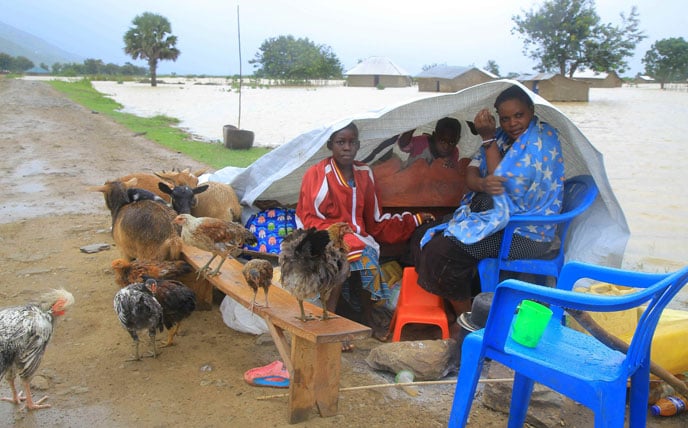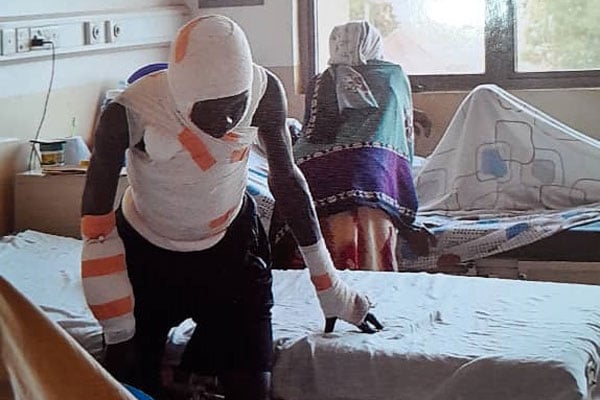River Semuliki floods leave thousands out in the cold

Family members take refuge on Bweramule-Kyobe roadside in Bweramule Sub-county in Ntoroko District after floods from River Semuliki cut off six sub-counties last week. PHOTO | ALEX ASHABA
What you need to know:
- Residents and leaders have reported a humanitarian crisis with significant impacts including stranded livestock, destroyed homes, and heightened health concerns due to the potential for disease outbreaks.
In the past three weeks, floods from River Semuliki have relentlessly hit Ntoroko District, submerging six cattle corridor sub-counties.
The floodwaters have also displaced hundreds of residents, who now face imminent hunger as vital access roads for food transportation remain cut off.
The most affected sub-counties include Bweramule, Butungama, Rwebisengo, Rwebisengo Town Council, Kanara, and parts of Kibuku.
Many residents have sought refuge along raised roadsides and under trees. Villages such as Kiraga, Budiba, Masojo, Rwetuhe, Makido, Kichwamba, Kyobe, and Kayaja have been particularly hard-hit.
Local leaders report that these sub-counties rely heavily on cattle keeping for their livelihood, selling milk to purchase food brought in from Fort Portal. However, all access roads to these areas have been severed, cutting off the food supply.
Ntoroko District Chairman William Kasoro, during an interview on Saturday, warned of a looming hunger crisis.
“These floods from River Semuliki are the worst we’ve seen. The UNRA road from Rwebisengo to Makodo to Kakara, which connects to Rwebisengo Town, has been completely cut off,” Mr Kasoro said, adding: “This road has been crucial for trucks coming from Fort Portal with food. For a week now, no truck can pass, and those that have tried have gotten stuck.”
Mr Kasoro emphasised the urgent need to create an emergency road to allow food trucks to deliver supplies to various markets in Rwebisengo Town.
“We submitted a disaster report last week as requested by the Prime Minister, but now we need to update it with the current situation. The affected population is over 50,000, with people sleeping on roadsides and in schools that are on higher ground. They need relief food immediately,” he said.
He also mentioned that together with the District Chief Administrative Officer, they will follow up on the disaster report to be sent to the Prime Minister next week and plan to request emergency funds from the Uganda Road Fund to repair the damaged roads.
Unlike the first flood earlier this month, which receded within three days, this second flood has persisted for about five days, continuously overflowing from River Semuliki.
Rwebisengo Sub-county Chairperson Christopher Mujungu reported that in Kiraga Parish, three out of four villages have been completely cut off, forcing residents to flee their homes.
“This is the worst flood we’ve experienced. The villages of Kiraga I & II and Rwebyoma are completely submerged, and everyone has left their homes. We are now appealing for help. During the first flooding at the beginning of this month, we received some relief items, but it was insufficient. We don’t know if we will receive any this time,” he said.
He added that the majority of people in his sub-county are cattle keepers, and for about a week, their cows have been standing in floodwaters, unable to graze, and have already started losing weight.
Ms Monica Kyobutungi from Kyobe Village said that since Wednesday, she and her family have been living on the roadside connecting Bweramule Sub-county and Rwibale Trading Center under harsh conditions. “We managed to rescue a few belongings, but others were left behind and destroyed. We are helpless, sleeping on the roadside. We have nothing to cook; the small cassava gardens around my house are submerged. Our cows are stuck in the water and cannot move—soon, they will start dying,” she said.
On August 8, Prime Minister Robinah Nabbanja appeared before Parliament to address concerns raised by area legislators Ibanda Rwemulikya and Youth Western MP Edison Rugumayo regarding the ongoing flood crisis in Ntoroko District.
In her response, she advised the legislators to obtain a comprehensive report from the district disaster committee to fully understand the impact of the floods.
She also assured them that her office would organise a meeting with Ntoroko leaders to discuss and find a lasting solution to the district’s recurring flood challenges.
The Semuliki River, which originates from Lake Edward, has its main catchment in the Rwenzori Mountains in Bundibugyo District.
It flows through Ntoroko District, forming the international boundary between Uganda and the DR Congo (DRC) before draining into Lake Albert.
On the Ugandan side, the riverbanks are collapsing, while on the DRC side, the absence of human activities has allowed vegetation to remain thick, preventing bank collapse.




